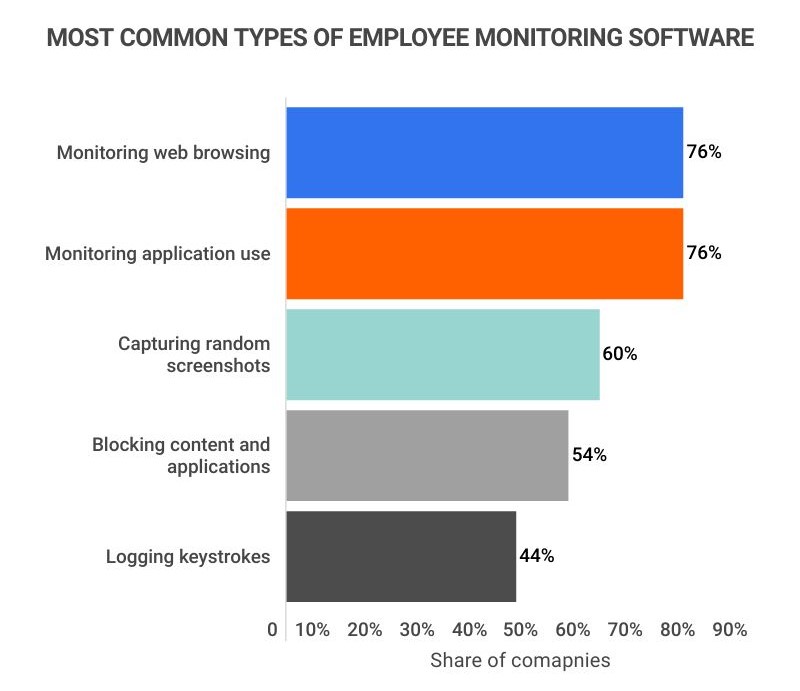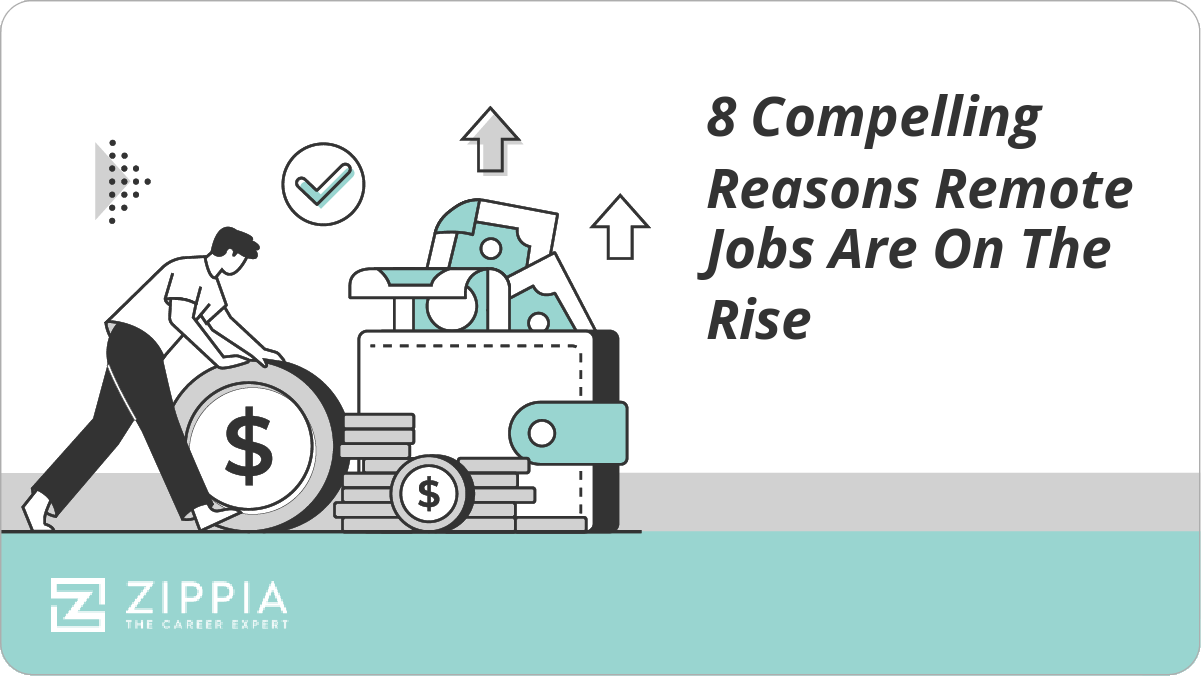Research Summary: Employers and employees can be at odds for many reasons, and employee monitoring is often one of those reasons. While employers worry about theft, lack of productivity, and other out-of-sight issues, many employees feel violated by certain types of surveillance.
Is there a balance to be had between these two points of view?
To find out more about the pros and cons of employee monitoring in the workplace, we’ve gathered an extensive list of statistics. According to our extensive research:
-
60% of companies with remote workers use employee monitoring software.
-
Global demand for employee monitoring software increased by 65% between 2019-2022.
-
67.6% of North American employers with 500+ employees use employee monitoring software
-
59% of employees feel stress and anxiety about workplace surveillance.
For further analysis, we broke down the data in the following ways:
Over Time | Opinions | Adoption Rate | Types of Employee

Employee Monitoring Over Time
The landscape and commonality of employee monitoring have changed significantly over time. Here are some essential facts to find out more about why employee monitoring has become such a big topic:
-
Between 2015-2020, companies that monitor their employees increased by over 166%.
The COVID-19 pandemic hugely impacted how common employee monitoring has become. It’s estimated that only 30% of companies monitored employees in 2015, compared to 80% in 2020.
-
Only 45% of companies electronically monitored employees in 1999.
That’s compared to the at least 80% who utilize electronic monitoring software today. In part, this can be explained by advancements in technology, but there’s also a concerning conversation about lacking trust in employees.
-
The employee monitoring software market is expected to have a CAGR of 12.1% through 2026.
Likely, the share of companies that use employee monitoring software in the workplace will only continue to increase over time. This is a considerable upward trend, given that the majority of companies already use employee monitoring software.
-
The global Employee Monitoring Software Market is worth $1.12 billion as of 2021.
And this massive value is only expected to increase going forward, projected to reach a potential $2.10 Billion by 2030 at a growth rate of 7.2%.
Opinions on Employee Monitoring
Opinions on employee monitoring are incredibly mixed, especially between employers and employees. Here are some examples of popular opinions on employee monitoring:
-
Only 30% of C-suite execs report themselves as “confident” that employee monitoring data will always be used responsibly.
That’s a remarkably low share of C-suite executives, given that approximately 62% of these same execs have their companies leverage new tools to collect data on their employees.
-
Only 30% of employees are comfortable with employers monitoring their email.
While this is up from 10% in 2015, the majority of employees still consider email monitoring to be a violation of privacy. However, whether or not email monitoring will continue being normalized going forward is unknown.
-
The number one reason why employers monitor employees is to better understand how employees are spending their time.
79% of employers say they monitor employees to better understand how employees are spending their time, followed by wanting to confirm employees are working a full day (65%) and ensuring they don’t use work equipment for personal use (50%).
Reason for monitoring employees Share of employers Better understand how employees are spending their time 79% Confirm employees are working a full day 65% Ensuring they don’t use work equipment for personal use 50% -
40% of employees are okay with tracking if it’s only used to improve performance and provide other personal benefits.
This isn’t the entire picture, though, as 23% of employees say they felt insecure about not accepting it, and a further 18% claim to only accept it out of pressure.
-
68% of managers believe employee monitoring improves performance.
A stark contrast to the 72% of employees who believe employee monitoring either diminishes performance or has no impact.
Employee Monitoring Adoption Rate
Despite the disapproval of many employees, the employee monitoring adoption rate has been increasing steadily over time. Here are some key facts about its adoption:
-
62% of organizations are leveraging new tools to collect data on their employees.
As technology evolves, more and more companies are exploring new tools to aid in employee monitoring. This has drawn the concern of some, who worry that new technologies could take monitoring too far.
-
60% of companies with remote workers use employee monitoring software.
The move to remote work in 2020 spurred a lot of companies to adopt monitoring software that would allow them to check in on their remote workers. Methods can include anything from checking emails to looking over social media.
-
90% of companies that employ freelancers use employee monitoring software.
Call it a lack of trust or simply an interest in imposing performance; the adoption of employee monitoring in the freelancing industry is incredibly common. Other industries with high employee monitoring adoption rates include:

Industry Employee monitoring adoption rate Freelancers 90% IT 85% Staffing Agencies 80% Financial Companies 60% Consultants 50% Law Firms 40% Accountants 30% Architects 30% -
IT companies only spend an average of 6% of their budget on security and monitoring.
Despite the fact that insiders (typically employees) are responsible for 22% of all security breaches, there’s a shocking lack of budget going toward reducing this issue.
-
Only 21% of employees think their employer is monitoring them.
Most employees are unaware of the prevalence of employee monitoring, with 49% believing that their company isn’t tracking them and only 13% being unsure.
Do you think your employer monitors you? Share of employees No 49% Yes 21% Unsure 13%
Types of Employee Monitoring
While some forms of employee monitoring, such as checking emails are used by most companies, there are a variety of different ways to keep an eye on employees. Consider these statistics:
-
94% of companies track employee emails.
Email tracking is the most common method of tracking employees, followed by Calls (87%), Video (87%), and Messages (85%)
Tracking method Share of companies Email 94% Call 87% Video 87% Messages 85% -
76% of employers primarily track employee habits by monitoring web browsing and application use.
These are the most common ways employee habits are tracked by employers, with others including capturing random screenshots (60%), blocking content and applications (54%), and logging keystrokes (44%).

Software tracking method Share of companies Monitoring web browsing 76% Monitoring application use 76% Capturing random screenshots 60% Blocking content and applications 54% Logging keystrokes 44% -
Employees spend an average of 2.9 hours per 8-hour workday doing non-work activities.
That’s approximately 36% of the entire workday, and if you want to know what employees are doing instead of working, here is a comprehensive chart:
Distracting activity Percentage of employees who participate Surf the internet 47% Social media 45% Texting 44% Bathroom breaks 39% Socializing with coworkers 27% Snack breaks 25% Other coworkers’/office noise 25% Coffee breaks 19% Reading/drawing 16% Household activities 14% -
Up to 60% of employers use employee monitoring to track potential union formation.
One of the reasons why employees are opposed to monitoring is that employers often use the tools to cool down any interest in forming a union.
Employee Monitoring FAQ
-
How common is employee monitoring?
Employee monitoring is very common in 2023. For example, 67.6% of North American employers with 500+ employees use employee monitoring software, and up to 94% of companies will monitor employee emails.
Not even remote workers are safe, as since the start of the pandemic, now 60% of employers also find ways to monitor their employees who work from home.
-
Is employee monitoring effective?
Yes and no, as employee monitoring is only typically effective with employee buy-in. Unsurprisingly, employees who find out second-hand that they’re being monitored might feel as though their privacy has been violated or that the company doesn’t trust them to do a good job.
This can lead employees to lose morale, build resentment, or walk away from their position all together.
On the other hand, when employees are agreeable to the idea of being monitored, the system can help catch errors, increase security, boost productivity, and more.
-
Is employee monitoring legal?
Yes, employee monitoring is legal in the US. However, this is specifically the case for workplace devices, as employers cannot hack into your Gmail or anonymous social media account to see what you’re up to.
Regarding company-owned phones, computers, and other devices, though, the US provides employers with a lot of leeways. Employers are free to monitor employees on these devices as much as they want and are under no obligation to disclose their monitoring practices to employees.
-
What is the main reason for employee monitoring?
The main reason cited by employers for employee monitoring is to improve productivity. 81% of employers believe that their employee monitoring software has improved productivity, but there are other reasons employers implement monitoring systems as well. These include:
-
Prevent internal theft
-
Increase cybersecurity
-
Ensure company resources are being used appropriately
-
Chill interest in unionizing
-
Provide evidence for any potential litigation
-
-
What are the negative effects of monitoring employees?
The main negative effects of employee monitoring occur when employees are aware of the system and disapprove of it.
For example, monitored employees are actually more likely to take unauthorized breaks, ignore instructions, steal or damage workplace property, and purposefully work more slowly. For a general picture of the downsides, here are some of the most pervasive to consider:
-
Reduced trust between employer and employees
-
Invasion of privacy
-
Companies having a false sense of security
-
Reduced employee morale
-
Reduced employee retention
-
Conclusion
Employee monitoring is a controversial topic, with employers and employees seemingly split on its merits. As of 2023, 67.6% of North American employers with 500+ employees use employee monitoring software, and up to 94% of companies will monitor employee emails. This is despite the fact that only 30% of employees are comfortable with the idea of being monitored.
If companies want to go forward with employee monitoring, it’s important to include employees in the process. The statistics show that employee monitoring is more successful when employees know about and buy into the process.
Ensuring that employees are well informed can make the difference between a negative workplace environment and a more positive and productive environment.
References
-
HRMorning – Survey: 60% of employers use monitoring software to watch remote workers
-
The Washington Post – Your boss can monitor your activities without special software
-
Skadden – Every Move You Make: When Monitoring Employees Gives Rise to Legal Risks
-
Forbes – Why 78% Of Employers Are Sacrificing Employee Trust By Spying On Them
-
LinkedIn – How Covid-19 has Accelerated the Use of Employee Monitoring
-
The Baltimore Sun – Companies can monitor their staffs’ every keystroke. Are rights violated?
-
HBR – How to Monitor Your Employees — While Respecting Their Privacy
-
DeskTrack – Famous Industries Which Used Employee Monitoring Software
-
Integrity360 – Three benchmarks to inform cyber security spending plans for 2020
- Statistics
- Employee Retention Statistics
- Happy Employees Are More Productive
- Workplace Distraction Statistics
- Average Freelancer Rates
- Average Working Hours
- Offboarding Statistics
- Employee Productivity Statistics
- Workplace Microagression Statistics
- Employee Monitoring Statistics
- Employee Training And Development Statistics
- Lead Generation Statistics





